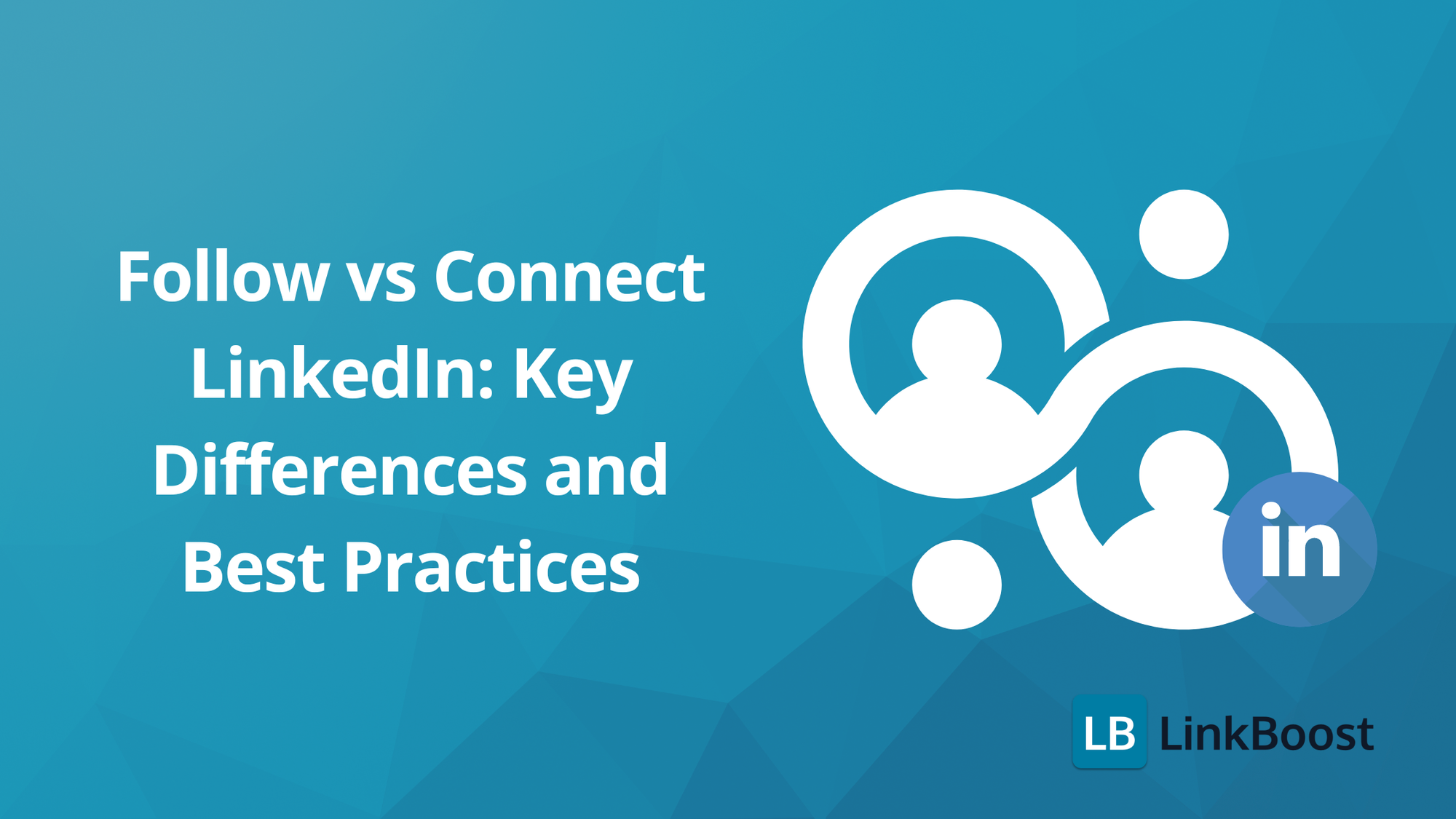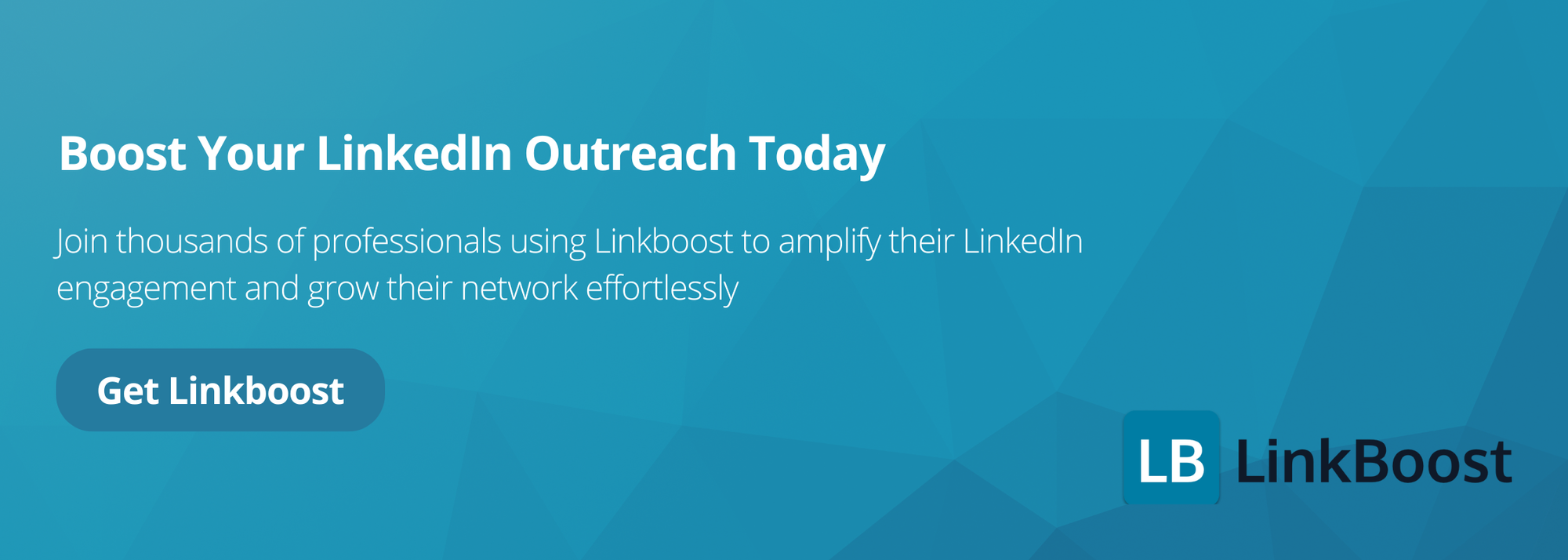Are Followers and Connections The Same On LinkedIn? Key Differences and Best Practices

Wondering whether to follow or connect on LinkedIn? This guide breaks down the key differences between “follow vs connect LinkedIn”, helping you decide which option suits your networking goals.
Key Takeaways
- LinkedIn connections establish a two-way relationship allowing both parties to see and interact with each other’s content, whereas following is a one-way interaction where you can see someone’s content but they do not see yours.
- Forming connections on LinkedIn can lead to job opportunities, business collaborations, and enhanced professional credibility through endorsements and recommendations.
- Following individuals on LinkedIn is ideal for content consumption from industry leaders without needing direct interaction, helping you stay informed and build credibility through engagement with their LinkedIn posts.

Understanding LinkedIn Connections vs. Followers
On the surface, the terms “followers” and “connections” on LinkedIn could be construed as similar, however, they denote distinct types of relationships. The main difference lies in the nature of the interaction. When you connect with someone on LinkedIn, it forms a two-way relationship. This means both parties can see each other’s content, message each other directly, and interact within each other’s networks. In contrast, following someone on LinkedIn is a one-way interaction. You can see and engage with their content, but they do not see yours unless they choose to follow you back. This is known as a one way connection, where the follower gains access to the posts of the person they are following, but the connection is not mutual.
There are manifold advantages to making connections on LinkedIn, including leveraging existing connections. Notably, connecting with someone provides access to their network, paving the way for fresh opportunities and collaborations. Furthermore, connections have the opportunity to:
- endorse and vouch for each other’s skills, thereby substantially improving your professional standing
- share and engage with each other’s content, increasing visibility and reach
- receive updates and notifications about each other’s activities and achievements
- see each other's posts, enabling two-way communication and engagement
It’s also worth noting that when you connect with someone, you automatically follow them unless you specifically choose to unfollow.
Conversely, following a person enables you to:
- Stay abreast of their content without establishing a reciprocal connection
- This can be particularly useful if you are interested in the insights and updates of industry leaders or other professionals who might not accept connection requests from individuals they do not know personally
- Followers can see the content of the person they follow but cannot message them or see their network of connections.
What are LinkedIn Connections?
LinkedIn connections are individuals you are directly connected to on the platform. When you connect with someone, you establish a two-way relationship that allows both parties to message each other without needing InMail and view each other’s profiles without limitations. Each connection you make expands your LinkedIn network, giving you access to a broader range of potential connections and opportunities.
To see your total connections, simply click on the “Connections” link on your profile. It’s important to note that LinkedIn imposes a 30,000 connection limit, so it’s wise to be strategic about who you connect with. Building a robust network of meaningful connections can significantly enhance your professional reach and open doors to new opportunities.
What are LinkedIn Followers?
LinkedIn followers are individuals who can see your posts and comments in their feed, allowing them to stay updated with your content without needing a direct connection. To follow someone, click the “+Follow” button on their profile. Once you follow someone, their posts and updates will regularly appear in your LinkedIn feed, keeping you informed about their activities and insights.
You can see who is following you by clicking on the “Followers” link on your profile. Unlike connections, followers do not give you access to their network, but they do help increase the visibility of your content. This makes following an excellent option for those who want to stay informed and engage with content from industry leaders and influencers without forming a mutual connection.
Benefits of Connecting on LinkedIn

Forming connections on LinkedIn goes beyond merely broadening your contact list; it can serve as a portal to a plethora of professional opportunities. One of the most significant benefits is the increased likelihood of job opportunities.
When you connect with someone, you become part of their network, which can lead to recommendations and introductions to potential employers. Many professionals have landed jobs simply because they were connected to the right people on LinkedIn.
For entrepreneurs and industry professionals, connections on LinkedIn may pave the way for fresh business collaborations and partnerships. By connecting with other LinkedIn members, you can:
- Discover potential clients, partners, and even investors
- Send direct messages and engage in meaningful conversations. Connections allow users to send messages back and forth, fostering deeper engagement and networking potential.
- Explore opportunities for collaboration
- Connect with industry leaders and gain access to valuable resources such as articles, webinars, and videos that can aid in your professional development.
Cultivating a strong LinkedIn network can also bolster your professional image. When you connect with someone on LinkedIn, you can endorse each other’s skills and provide recommendations, which can significantly boost your credibility and professional standing. Furthermore, forming lasting professional relationships through LinkedIn can lead to mentorship opportunities, knowledge exchange, and personal growth.
Advantages of Following on LinkedIn
Choosing to follow someone on LinkedIn comes with its unique benefits, especially for those who prioritize content consumption over direct engagement. By following individuals, you can keep your LinkedIn feed filled with insightful posts, articles, and updates from experts in various fields. This allows you to stay informed about the latest trends and developments in your industry without the need for a personal connection.
Moreover, following is an excellent way to engage with a broader range of professionals. You can interact with their content by liking, commenting, and sharing, which can help you build visibility and credibility within your industry. It's an effective strategy for those who wish to learn and stay updated without the commitment that comes with direct connections, while also fostering deeper interactions.
How to Follow Someone on LinkedIn
The process of following someone on LinkedIn is uncomplicated, and being familiar with the steps can simplify it further. You can find people to follow from various sections of LinkedIn, such as:
- Your feed
- The Notifications tab
- The My Network page
- Using the Search bar at the top of the page
This flexibility allows you to discover and follow professionals whose content you find valuable.
To follow someone, simply visit their LinkedIn profile page and click the ‘Follow' button. Once you start following someone, they will receive a notification, which can sometimes lead to them checking out your profile in return. This is a great way to keep your feed filled with relevant content while also potentially attracting attention to your own LinkedIn profile.
How to Connect with Someone on LinkedIn
Establishing a connection with someone on LinkedIn necessitates a tad more effort compared to following, yet the benefits can be significant. One of the first steps is to personalize your connection request. Mention commonalities or specific interests to make your request stand out. For example, if you attended the same conference or share a mutual connection, highlight that in your message.
It's also essential to explain the value of the connection for both parties. Whether you're seeking advice, looking to collaborate, or simply want to expand your network, make it clear why connecting would be beneficial. Avoid overly formal language and keep the tone conversational to make your message more approachable. Remember, LinkedIn limits connection requests to 300 characters, so keep your message brief and to the point.
End your message with a clear call to action, such as accepting the invite or suggesting a time to discuss potential collaborations. Personalizing your connection requests not only increases the likelihood of acceptance but also sets the stage for a meaningful professional relationship through direct message.
Crafting a Strong Connection Request
When sending a connection request, it’s essential to craft a strong message that grabs the attention of the recipient. Here are some tips to help you create a compelling connection request:
- Personalize your message: Address the recipient by their name and mention how you came across their profile.
- Clearly state your intentions: Explain why you want to connect with them and what you hope to achieve.
- Keep it concise: Keep your message brief and to the point.
- Use a professional tone: Avoid using jargon or overly casual language.
Example of a strong connection request:
“Hi [First Name], I came across your profile while researching [industry/field] and was impressed by your experience in [specific area]. I’d love to connect with you and learn more about your work. Let’s start a conversation!”
Personalizing your connection requests not only increases the likelihood of acceptance but also sets the stage for a meaningful professional relationship.
When to Follow vs. Connect on LinkedIn

The decision to either follow or connect with someone on LinkedIn hinges on your objectives and the degree of interaction you desire. Following is best when you are primarily interested in someone's content, insights, or updates but do not require direct communication. This approach is useful for staying informed about influential professionals and industry trends without needing a mutual relationship.
Connecting, on the other hand, is preferable when you want to build a relationship, engage in conversations, or have direct communication with someone. If you're looking to collaborate, seek mentorship, or need to engage more deeply, sending a connection request is the way to go. You can always start by following someone to learn more about their content and then decide to connect later.
Tips for Managing Your LinkedIn Network
Effectively managing your LinkedIn network guarantees a consistently relevant and valuable feed. One practical tip is to unfollow users whose content is no longer relevant to you. Unfollowing someone will hide their updates from your feed, but you’ll remain connected if you’re already connected. This helps maintain the quality of your LinkedIn feed without severing professional ties. Additionally, managing LinkedIn contacts is crucial to keep track of your network, as LinkedIn separates followers and connections, making it challenging to stay organized.
Regularly reviewing your ‘Posts and Activity’ section under the ‘Me’ dropdown menu can help you manage who you’re following and who is following you. This section allows you to see all your interactions and manage your followers effectively. If your news feed becomes diluted with too much content, consider unfollowing a few people to improve its relevance.
Additionally, using the ‘following’ option to view and manage accounts you’re following but not connected to can help streamline your network. By sorting profiles you’re following but not connected to, you can ensure that your feed remains focused on the most valuable and relevant content.
How to Turn On Follow First Mode on LinkedIn
To turn on Follow First mode on desktop, follow these steps:
- Go to your profile and click on the “More” menu.
- Select “Settings” from the dropdown menu.
- Scroll down to the “Follow first” section.
- Toggle the switch to “On”.
To turn on Follow First mode on mobile, follow these steps:
- Go to your profile and tap on the three dots in the top right corner.
- Select “Settings” from the menu.
- Scroll down to the “Follow first” section.
- Toggle the switch to “On”.
Enabling Follow First mode can increase your follower rate and get more eyeballs on your content, making it a valuable tool for enhancing your LinkedIn presence.
How to See How Many People Follow You on LinkedIn
To see your current follower count and the names of those following you, follow these steps:
- Go to your profile and click on the “Followers” link.
- You’ll see a list of people who are following you, ordered by who followed you most recently.
- You can also see your total follower count at the top of the page.
Note that you can only see the names of people who are following you if they have made their follower list public. This feature allows you to understand your audience better and tailor your content to engage your followers effectively.
Leveraging Creator Mode for More Followers
Should you aim to boost your LinkedIn followers count and enhance visibility on LinkedIn, making use of the Creator Mode can prove extremely beneficial for LinkedIn users. By switching the default Connect button to a Follow button, you can attract more followers to your content. This mode encourages other users to follow you first, increasing the rate of new followers and the visibility of your posts.
To turn on LinkedIn Creator Mode, follow these steps:
- Decide on 1-5 topics (hashtags) you frequently post about. This helps categorize your content and make it easier for other users to find and follow you.
- Access your profile and click on “Creator mode preview”.
- Add the hashtags you have chosen.
- Follow the prompts to activate Creator Mode.
- This can be done on both desktop and mobile apps.
Enhancing your profile with a responsive banner that includes calls to action and arrows pointing to the follow button can also attract more followers. Providing a brief explanation of why people should follow you can make your profile more appealing and increase your follower count.
Engaging with Your LinkedIn Audience
Interacting with your LinkedIn audience is vital in cultivating substantial connections and amplifying your visibility. Consistency is key; posting regularly and engaging authentically with your network can help you gradually build a substantial following. Interacting with your connections' posts by liking, commenting, and sharing helps foster relationships and boosts your profile's visibility.
Sharing valuable and relevant content, such as industry insights and thought leadership articles, can attract and engage your audience. Publishing long-form articles on LinkedIn demonstrates your expertise and can draw followers interested in in-depth content. Using relevant hashtags in your posts can also increase your visibility beyond your immediate network.
Joining and actively participating in LinkedIn groups related to your professional interests can expand your network and expose your content to a broader audience. Cross-promoting your LinkedIn profile on other social media platforms can further extend your reach and attract new followers.
Common Mistakes to Avoid on LinkedIn
Circumventing frequent errors on LinkedIn can markedly improve your networking experience. One frequent error is sending generic connection requests. Personalizing your LinkedIn message can make a significant difference in the acceptance rate. Another mistake is attempting to connect with people who have an excessively large number of followers, as your request is more likely to be overlooked.
Connecting aimlessly with many people can dilute the value of your LinkedIn network. It's better to focus on building meaningful connections that align with your professional goals. Lastly, not utilizing LinkedIn's automation tools can make managing connections and engagements more challenging.
Summary
Understanding the differences between following and connecting on LinkedIn is crucial for leveraging the platform effectively. While connections offer deeper engagement and mutual benefits, following allows you to stay updated with valuable content without needing a personal connection. Each has its unique advantages, and knowing when to use each can significantly impact your professional growth.
Mastering LinkedIn's features, from managing your network to leveraging Creator Mode, can enhance your visibility and professional reputation. By applying these strategies, you can build a robust LinkedIn presence that supports your career goals and fosters meaningful professional relationships.
Frequently Asked Questions
What is the main difference between following and connecting on LinkedIn?
The main difference is that connections involve a two-way relationship for content and messaging, while following is a one-way interaction focused on content consumption.
How can I follow someone on LinkedIn?
To follow someone on LinkedIn, visit their profile page and click the 'Follow' button. They will receive a notification that you have started following them.
What are the benefits of connecting on LinkedIn?
Connecting on LinkedIn can increase job opportunities, lead to business collaborations, and enhance your professional reputation through endorsements and recommendations. These benefits can significantly boost your career prospects.
When should I follow someone instead of connecting on LinkedIn?
You should follow someone on LinkedIn if you are interested in their content and updates, but do not need direct communication with them. Following is a convenient way to stay informed about industry insights without forming a mutual relationship.
What is LinkedIn Creator Mode, and how can it help me gain more followers?
LinkedIn Creator Mode can help you gain more followers by switching the default Connect button to a Follow button, making it easier for users to follow your content and increase your visibility and follower count through relevant hashtags. Try activating Creator Mode to enhance your presence on LinkedIn.

